Surveillance Camera Video Distribution
Your selection of a distribution method can have an impact on your camera selection, how and where you can watch the video, how you record and playback the video, and the wiring in general. Here are some options for surveillance video distribution:
- Note 1: Be sure your camera video outputs match the inputs for your video selector.
- Note 2: Technically, any camera (wired or wireless) can be connected to a DVR or computer for digital recording or Internet Distribution. This can be combined with any of the options below, and is covered as the last option below.
See our page on Wire Types for information on component, composite, coaxial, BNC... cabling.
Switchers / Video Selectors
This is a simple solution using a component designed for home theater. The switcher or video selector takes 2 or more inputs (usually Composite or S-Video connectors) and has a single output which you connect to your TV. You use either the remote or the buttons on the front to select which input to view. You can only watch a single camera at a time. Some more advanced switchers (not the home theater variety) will change cameras automatically when motion is detected on that camera or will continuously loop through each camera showing a second of video at a time.
Remote ViewingVideo Selectors are designed to run to a single Television. If you try to split the wire to run to multiple TVs you will probably degrade the signal too much to be usable. You can use a RF modulator to convert the video to coaxial cable (maybe with an additional coaxial booster) which should help if you want to distribute the video throughout the home. You will still have to watch the same camera on every television and you can only select which camera to view from a single location.
RecordingThis method doesn't allow for recording more than one camera and it is typically not what you would use if recording was important. Recording can be done using a VCR between the Video Selector and the TV.
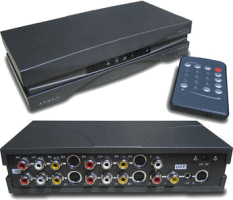
Wireless
A wireless system is usually a custom package that includes wireless cameras (that can also be wired), wired power adapters and cables for the cameras, and a receiver module. The cameras usually need to be plugged into a wall. They can be run from batteries, but the required cabling is not provided to do so. Like the Video Selector above, there is usually only one video output on the low end kits so you can't watch or record more than one camera at a time. To view multiple cameras you would need multiple receiver modules.
Remote ViewingThe video from a wireless system can be distributed just as the Video Selector above. You also have the option of purchasing multiple wireless receivers for each room you want to view the cameras. With this method you can watch a different camera from each room and you don't need to run any wires between the rooms.
RecordingWith a simple wireless kit the video can be recorded with a VCR as above. Some higher end kits have more options for automatically changing cameras when motion is detected or changing cameras every second... Some receivers even have built in hard drive storage for digital recording and Internet connectivity allowing you to view real time or recorded video from anywhere.
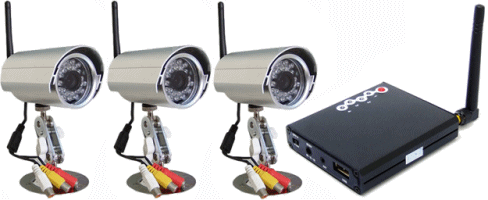
X10 Wireless Video System
In a typical wireless system all of the cameras transmit video at all times on different channels and the receiver unit selects a specific channel to display. In this X10 system every camera transmits on the same channel, but only one camera is on at a time. Selecting a camera from the remote control sends a signal that turns on that camera and turns off every other camera. That way only one camera is transmitting at a time, which is required since only one camera can use a channel at a time. This X10 remote can also be used to pan & tilt (blue buttons) the currently selected camera if it is connected to a motorized base.
Remote ViewingThis is similar to the low end wireless options above. You can distribute the video signal from the receiver throughout the home or you can get a separate wireless receiver for each room. Unlike the non-X10 Wireless option above, even with two receivers each receiver must view the same camera.
RecordingAgain, your basic option is to record the selected video using a VCR.
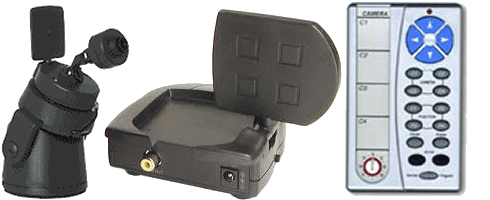
X10 Composite Wired Video System
Like the X10 Wireless system, this system works by turning off all but one camera at a time using an X10 remote. The composite wires from each camera are merged into a single line by using Composite splitters (Y-cables) backwards.
Remote ViewingThe same options exist as the Video Selector above, requiring composite or coaxial cables be run to every TV.
RecordingRecording is done using a VCR. Only a single camera can be recorded at a time.

TV Tuner Selection
For this option you will need a RF Modulator for each camera being used. The RF Modulator must be the type that allows you to select the channel for the camera. For example, in a 3 channel system you connect the composite cable from camera #1 to a RF Modulator and set the modulator to Channel 10. For camera #2 use Channel 20. For camera #3 use Channel 30. Keep the channels far apart to reduce interference. Then take the coaxial outputs from each RF Modulator and combine then into a single coaxial line using a coaxial cable splitter backwards. Now, run this coaxial cable to any TV in your home and use your TV remote to select the camera. Channel 20 for camera #1... If you are already using the Coaxial input on your TV, then use a Coaxial A/B switch to select between the cable/satellite/antenna wire and the cameras.
Remote ViewingThis method allows any Television in the home to view a different camera, and you select the camera from the TV instead of a single common location. Use a normal coaxial splitter (used normally - not backwards) to divide the coaxial cable for multiple televisions.
RecordingVCR can be used to record a single camera.
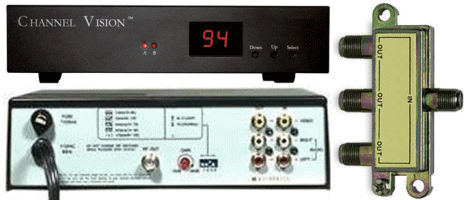
Quads
Quads get their name from their ability to display 4 cameras at a time on a single monitor - one in each corner. A basic Quad system takes four camera inputs and displays all 4 cameras at once in a 2x2 grid. Higher end Quad systems can take more inputs and are capable of showing 9 (3x3) or 16 (4x4) inputs at a time. These systems are still referred to as Quads regardless of the number of inputs or the number of cameras that can be displayed at a time. Some quads have additional features: some can detect motion in the video signal and automatically switch cameras, some can also loop through each camera showing each camera for 1 second (or more) before moving to the next camera, some support Picture in Picture for 2 camera viewing... Quads typically take RCA/Composite or BNC cables for input and VGA, RCA/Composite or BNC for output. If necessary you can convert Composite to/from BNC. See our page on Wiring Conversions for more information.
Remote ViewingQuads don't offer any special remote viewing capabilities.
RecordingThe Quads ability to show more than one camera at a time or to loop through different channels allows you to record more than one camera with a single VCR. Note that if you show multiple cameras at a time, then the video quality will be reduced - by 75% for a 2x2 Quad. Looping doesn't give you a continuous video, but the video quality will be much higher. The major issue with Quads is that you can only watch what is being displayed on the TV. If someone switches from 2x2 mode to look at only one camera, then you are now only recording that single camera.
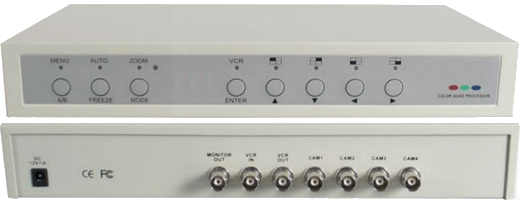
Multiplexers
Multiplexers have all of the functionality of a Quad system with the added ability to record every camera simultaneously regardless of how you are currently viewing the cameras. In an analog system, the multiplexer records a frame from each camera in sequence. The more cameras you have the less frames per second you have for each camera. The video will be choppy with a lot of cameras, but each camera is recorded at its full resolution - which is much more important when trying to identify intruders. In a digital system (DVR - Digital Video Recorder) the video is saved to a computer hard drive where frame rate is limited by computer processing power and hard drive speeds.
Remote ViewingSome multiplexers support multiple outputs allowing the video to be viewed from multiple locations. Others support an Internet connection allowing for remote viewing of live or recorded video from anywhere. Otherwise, you will have to split the output video signal to view at multiple locations, but you will have to watch the same camera from each location.
RecordingUnlike Quad systems, what you are watching has no impact on what is recorded. For example: You can view camera #1 live, and then go back and view a recording of camera #2 during that time. You can view a 2x2 grid of video live, and then view 1 camera of recorded video - or view a 2x2 of live video and a single camera of recorded video.

Computer Web Cam
A standard computer USB web cam is a simple way to view and record video from a single camera. Quality, resolution, frame rate... are all limited by how much you spend on the camera. You can get a cheap camera for as little as $20.
Remote ViewingWeb cam software will allow you to view live or recorded video from anywhere using the computer's internet connection.
RecordingWith the right software you can record the video to the computer hard drive on demand, by timer, or when the computer detects motion in the video signal.
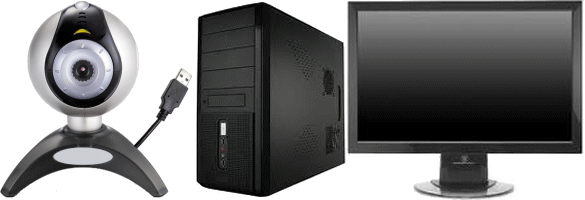
Computer Based System
The kit for a computer based surveillance system usually includes cameras, software, and possibly a camera input card for your computer. Older systems required a special PCI camera input card because USB 2.0 did not have sufficient bandwidth for high resolution video camera. USB 3.0 is fast enough to handle multiple high resolution cameras simultaneously. Viewing options are only limited by software, and usually match those of the best Quads or Multiplexers.
Remote ViewingThe included software should allow you to view live or recorded video from anywhere using the computer's Internet connection.
RecordingAll cameras are recorded to the computer's drive at all times. Recording capacity is only limited by the size of your computer hard drive. Like a Multiplexer, you can watch prerecorded video and record live video at the same time. Since the recording is digital there is no degradation of the video signal over time.
